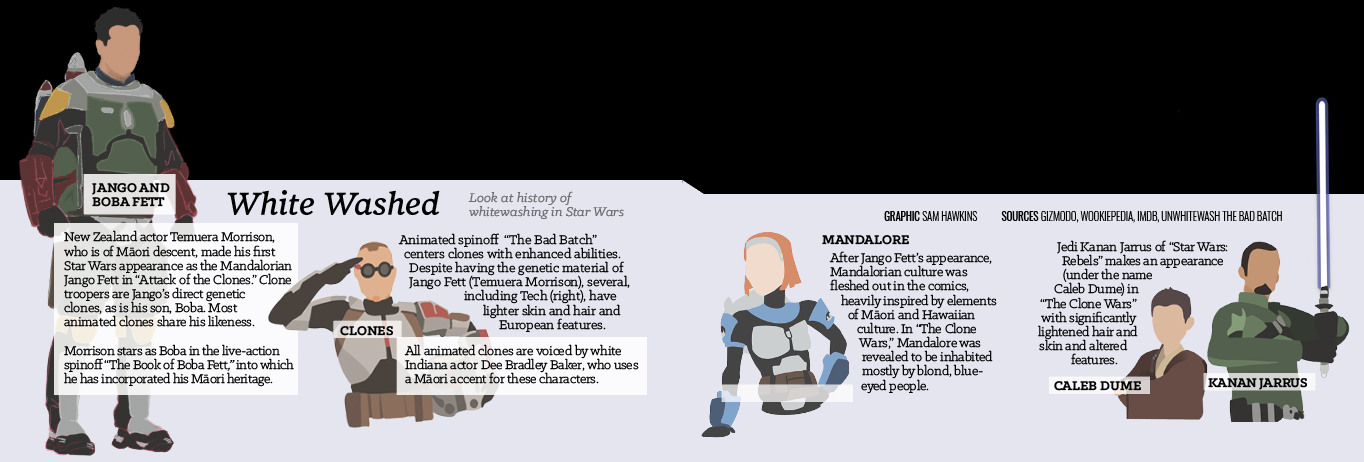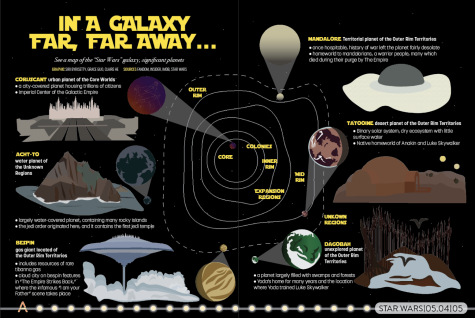Respect the Cultures
Lucasfilm should take responsibility for whitewashing, respect actors’ culture
 On May 4, 2021, “Star Wars: The Bad Batch” released on Disney+. “The Bad Batch” acts like the eighth season of the Clone Wars. It follows Clone Force 99, affectionately known as the Bad Batch, and their adventures while fleeing the newly established Empire. The Bad Batch consists of clones with “desirable mutations,” setting them apart from the traditional clone model.
On May 4, 2021, “Star Wars: The Bad Batch” released on Disney+. “The Bad Batch” acts like the eighth season of the Clone Wars. It follows Clone Force 99, affectionately known as the Bad Batch, and their adventures while fleeing the newly established Empire. The Bad Batch consists of clones with “desirable mutations,” setting them apart from the traditional clone model.
In Star Wars’ prequel trilogy, the clones and their genetic template, Jango Fett, were played by Temuera Morrison, who is Māori, of Te Arawa and Tainui descent. When the Star Wars animated series came out, the clone models mostly looked like animated versions of Morrison. Throughout the multiple stylistic and graphic changes in the seven seasons of “The Clone Wars,” the one unchanged factor has been the clone troopers’ darker complexion, based on Morrison’s Polynesian background.
From their first appearance in “The Clone Wars,” the Bad Batch has defied this trend. The character design for the Bad Batch clones have differed in height, facial structure and skin tone from the other clones in the GAR.
Hunter and Wrecker have darker skin tones; Wrecker is notably larger than other clones. Crosshair and Tech, on the other hand, have lightened hair colors and skin tones, with sharper facial features differing from Morrison’s. Echo, the only standard clone, maintains similar facial characteristics but been entirely drained of his skin color, not just appearing as Caucasian but literally white.
The issue isn’t restricted to the main characters. Omega, a “defective” female clone, has blonde hair and light skin. Caleb Dume, who grows up to become Kanan Jarrus, the main character in “Star Wars: Rebels,” appears in the debut episode with remarkably pale skin, a major difference from Jarrus’ warm and dark complexion in the “Rebels” show.
Fans of Star Wars issued a petition, calling for Lucasfilm to “Unwhitewash the Bad Batch.” Sources revealed that in the last week before the premiere, lighting adjustments were made to “The Bad Batch.” Still, no actual response was issued to the claim that Lucasfilm lightened the characters’ skin color.

Still, in the live action show “The Mandalorian,” Lucasfilm proved it could respectfully work with an actor and their cultural background. The second season of “The Mandalorian” took a completely new look at the feared bounty hunter, Boba Fett. Boba Fett is another clone of Jango Fett and also played by Morrison. In “The Mandalorian,” Morrison intentionally talked with Lucasfilm to add aspects of his own cultural background into the character.
Morrison said in an interview that he drew on the art of “haka” (war dance, directly translated to “fire breath”) in his fighting scenes as Boba Fett. The staff that Boba Fett uses in the fight scene against stormtroopers was also a part of Māori culture. Morrison said he trained with a “taiaha” (long fighting staff) as a child and wanted to bring that into production.
It’s obvious that Morrison worked hard to incorporate his Māori background into his character, and it’s evidence that actors’ cultural identities can add even more richness and complexity to their characters. As the Star Wars universe continues to grow, Lucasfilm should continue to work with actors to incorporate their cultural backgrounds into their characters.






